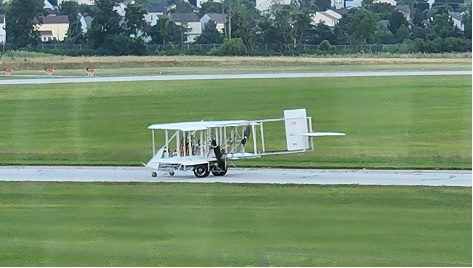It's a Team's Life

Wright B Flyer
If you like aviation history than you might like this. Not long ago we were heading to the house after delivering a load locally. We have to drive by the Dayton – Wright Brothers Airport which is a public airport south of Dayton, OH to get to the house. We have lived in the area since 1994 and this was the first time, we got to see the replica of the 1911 Wright B flyer that is housed at the airport, it was taxing to take off (the picture above we took).
This replica plane was built, maintained, and flown by an all-volunteer, not-for-profit corporation named Wright “B” Flyer Inc. They have been flying its one-of-a-kind lookalikes since 1983, in cooperation with the National Park Service and the U.S. Air Force.
They have/had three versions of the replica one is the flyable “Brown Bird”, the non-flyable “Yellow Bird” and a smaller scale “Silver Bird”. All versions have been all over the world and different events with the “Silver Bird” being built to fit easier into the cargo hold of an airplane. The “Silver Bird” was lost to a crash only after 25 hours of flight time.
A little history on the Wright Brothers plane development:
The original plane was invented and built by Wilbur and Orville in downtown Dayton, OH. It was where they developed their skills working on printing presses, bicycles, motors, and other machinery. Working on bicycles in particular was what honed the skills they needed to build a flying machine with a motor. From 1900 until the very first flight in late 1903 they used gliders to develop their flying skills. The brothers are widely credited with inventing, building, and flying the first motor powered plane, which was first flown on December 17, 1903 in Kitty Hawk, NC.
Their biggest breakthrough was the three-axis control system. The system is controls for yaw, pitch, and roll. Yaw is the main vertical tall stabilizer that controls the plane turning left and right. Pitch is the horizontal tail where it makes the pane go up and down. Then the roll is controlled from the main wings. It allows the plane to angle to the left and right. This system is still the standard on all fixed winged aircraft today.
Sandy & Stephen
Pinch Hitting for TeamCaffee
